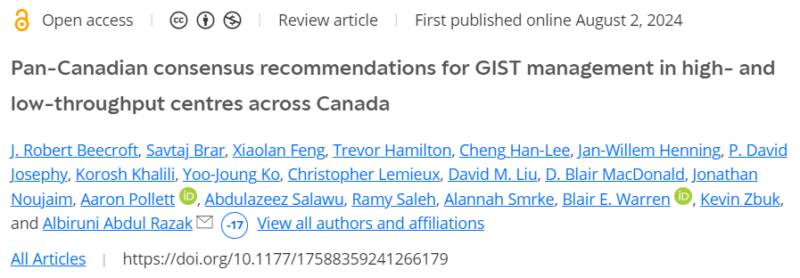Authors: J. Robert Beecroft, Savtaj Brar, Xiaolan Feng, Trevor Hamilton, Cheng Han-Lee, Jan-Willem Henning, P. David Josephy, Korosh Khalili, Yoo-Joung Ko, Christopher Lemieux, David M. Liu, D. Blair MacDonald, Jonathan Noujaim, Aaron Pollett, Abdulazeez Salawu, Ramy Saleh, Alannah Smrke, Blair E. Warren and Albiruni Abdul Razak.

Published in Therapeutic Advances in Medical Oncology, Sage Journals in August 2, 2024
Introduction
Gastrointestinal stromal tumors (GISTs) are rare mesenchymal tumors that have seen significant advancements in understanding and treatment over recent years. However, the provincially-administered Canadian healthcare system has led to inconsistencies in GIST management across the country. This article presents a comprehensive consensus from Canadian GIST experts, aiming to standardize and optimize the approach to GIST management nationwide.
Design/Method
A panel of 20 Canadian physicians, including radiologists, pathologists, interventional radiologists, surgeons, and medical oncologists, convened to address the inconsistencies in GIST treatment. They reviewed relevant literature focused on seven key domains: molecular profiling, radiological techniques/reporting, targeted localized therapy, systemic treatments, emerging tests, multidisciplinary care, and patient advocacy. The experts then developed consensus recommendations based on this literature review, their clinical expertise, and opinions.
What We Learned
- Diagnosis and Classification:
- GISTs should be stained with CD117 or DOG-1 for accurate diagnosis.
- Molecular testing is crucial for unresectable metastatic GISTs and those with moderate to high-risk stratification.
- Contrast-enhanced CT remains the primary imaging modality for staging, follow-up, and surveillance.
- Surgical Management:
- Complete surgical resection is the goal for primary resectable, non-metastatic GISTs.
- Neoadjuvant therapy should be considered when there’s an increased risk of morbidity with upfront resection or multi-organ involvement.
- Medical Management:
- Tumor genotyping is essential before initiating medical management.
- Imatinib is the first-line therapy for most patients, but 10-15% are imatinib-resistant.
- For KIT-mutant metastatic disease progressing on imatinib, dose escalation is recommended.
- Sunitinib is the standard second-line therapy, followed by regorafenib and ripretinib as third- and fourth-line options, respectively.
- Multidisciplinary Approach:
- Early referral to specialized high-volume centers is strongly advocated to optimize treatment options and improve outcomes.
Key Highlights
- Molecular Profiling:
- 75% of GISTs have KIT mutations, 10% have PDGFRA mutations, and 15% are wild-type.
- Wild-type GISTs require comprehensive next-generation sequencing for rare molecular drivers.
- Treatment Sequencing:
- Adjuvant therapy is recommended for intermediate to high-risk resected GISTs.
- In the metastatic setting, the treatment sequence typically follows: imatinib → sunitinib → regorafenib → ripretinib.
- Locoregional Therapies:
- For select patients with low-volume disease or limited progression, options like metastasectomy, stereotactic body radiation therapy, and ablative procedures can be considered.
- Emerging Role of Liquid Biopsy:
- Circulating tumor DNA (ctDNA) testing shows promise for real-time monitoring of treatment response and identifying resistant biomarkers.
- Patient Advocacy:
- The GIST Sarcoma Life Raft Group Canada (LRGC) provides crucial support, education, and advocacy for Canadian GIST patients.
Key Takeaway Messages
- Standardization is needed: The consensus recommendations aim to harmonize GIST management across Canada, addressing inconsistencies due to the provincial healthcare system.
- Personalized approach is key: Molecular profiling and genotyping are essential for tailoring treatment strategies to individual patients.
- Multidisciplinary care is vital: Early referral to specialized high-volume centers can significantly improve patient outcomes.
- Continuous monitoring is necessary: Regular imaging and potential use of liquid biopsies can help detect disease progression and guide treatment adjustments.
- Patient support matters: Organizations like LRGC play a crucial role in providing emotional support, education, and advocacy for GIST patients.
- Future developments are promising: Emerging technologies like liquid biopsies and ongoing clinical trials may further revolutionize GIST management in the coming years.
In conclusion, this expert consensus provides a comprehensive framework for standardizing and optimizing GIST management across Canada. By addressing the unique challenges of the Canadian healthcare system and incorporating the latest advancements in GIST research, these recommendations aim to improve patient care, treatment outcomes, and quality of life for individuals living with GISTs.
Find more articles on OncoDaily.
